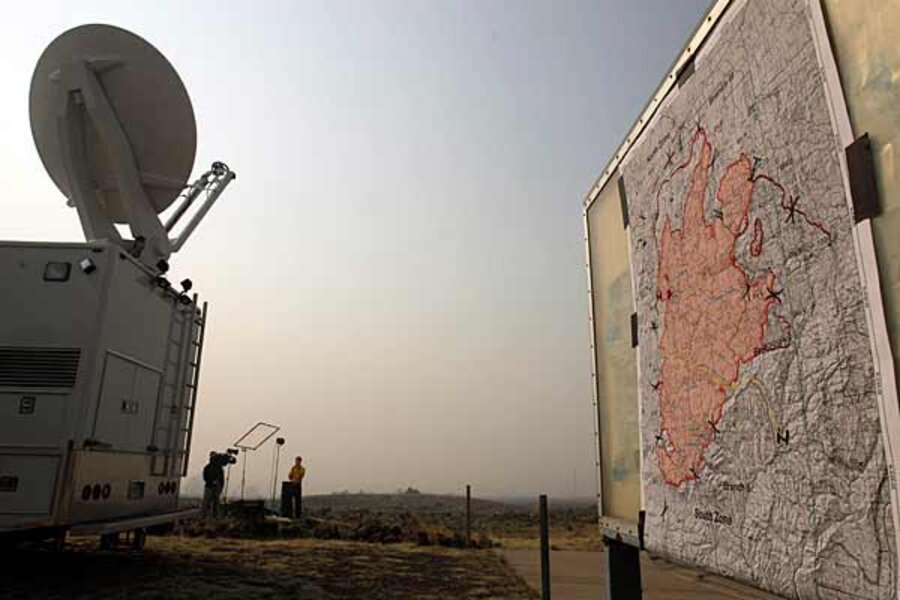Monster wildfire in Arizona: A glimpse of what climate change could bring
Loading...
A wildfire in Arizona that has blackened an area half the size of Rhode Island, prompted the evacuation of some 2,000 people in its path, and is threatening long-distance power lines that serve New Mexico and Texas, is the latest poster child for what some scientists see as a long-term trend toward larger, longer-lived wildfires in the American West.
And as researchers explore the causes, climate change appears to be an important contributor.
Nor is Arizona, which is battling three major blazes, alone in watching significant acreage go up in smoke this year.
In Texas, whose fire season officially starts each Nov. 15, wildfires have already consumed a record 2.8 million acres this season, according to the state's Forest Service. That eclipses by far the record set during the 2006 fire season, when wildfires burned nearly 2 million acres.
In Florida, firefighters are working to douse 35 wildfires larger than 100 acres, the largest of which has burned just over 160,000 acres near the Florida-Georgia border.
Fire statistics gathered at the National Interagency Fire Center (NIFC) in Boise, Idaho, give a rough glimpse of the trend toward more scorched earth in the US.
From 1960, when the center's tally begins, through 2010, wildfires throughout the US burned an average of 4.2 million acres a year. Between 2000 and 2010, however, the average rose to 6.6 million acres a year. Six of the last 11 years saw from 7 million to nearly 10 million acres burned. Between 1960 and 2000, only two years reached the 6-million-acre mark.
So far this calendar year, wildfires in the US have burned 3.1 million acres, according to the NIFC.
Persistent drought along southern tier
Conditions leading to this year's fires along the southern tier include the persistence of long-term droughts, which in the Southwest in particular have lasted for a decade, although with some minor breaks, notes Tom Swetnam, a fire ecologist at the University of Arizona's Laboratory of Tree Ring Research.
In addition, he says, La Nina conditions – cooler than normal surface water – in the tropical Pacific, in place since October, have tended to drive storm tracks along the northern US. This has tended to further dry an already parched landscape.
As La Nina weakens, and the rainy season begins in the Southeast, forecasters at the National Oceanic and Atmospheric Administration's Climate Prediction Center say they see some easing of drought conditions in many regions along the southern tier – but in many cases not enough to erase the drought itself.
But the longer-term trend in large, longer-lasting fires looks to be driven at least in part by global warming, which most atmospheric scientists attribute to a build-up of carbon-dioxide in the atmosphere – released through burning fossil fuels and through land-use changes.
Researchers documented the change in a study published in 2006 – in the middle of a four-year period when wildfires consistently consumed more than 8 million acres a year in the US. The increase in larger fires began somewhat abruptly in the mid-1980s, according to the study, which analyzed fire, climate and hydrological data between 1970 and 2004.
"This jump means something more than just the fuels," says Swetnam, a member of the research team, referring to a buildup in scrub growth and brush in some terrain that has also fueled wildfires.
The increase in larger, longer-lasting fires was most pronounced in the northern Rockies and at high elevations.
"That argued more in favor of a climate effect than a Smokey Bear effect" in which humans have contributed to a buildup in fuels by interfering in natural fire cycles, he says. The climate change manifests itself as warmer temperatures and earlier springlike temperatures, which increases the likelihood of longer dry spells.
Subsequent work the team has done since then has reinforced the earlier study's conclusions, Swetnam says.
As a fire ecologist, he says he's keeping a close eye on Arizona's Wallow fire, which has torched more than 300,000 acres in northeastern Arizona. It stands to dramatically alter the landscape for some time to come, he says.
Fears for Ponderosa forests
Arizona's fires – especially the Wallow fire – are burning their way through Ponderosa Pine forests, and "from the tree-ring record, these events are very strange," Swetnam says.
They are creating extremely wide gaps in a forest whose trees do not respond as well to fires as did Yellowstone's lodgepole pines following a devastating fire there in 1988.
Ecologists were stunned at how quickly the forest began its recovery following that blaze, which scorched nearly 800,000 acres. Burnt Lodgepoles respond to fire by dropping their pine cones after a fire passes, allowing the seeds in the remaining pine cones to find fertile soil.
Pondserosa's don't do that, Swetnam explains. They produce seeds erratically and drop them right away, with long stretches of time between seed production, dramatically slowing the recovery of the forest.
Instead, vegetation in the burnt Ponderosa areas could well convert to wild grasslands and shrubs that could dominate the landscape for a long time to come, he says.





